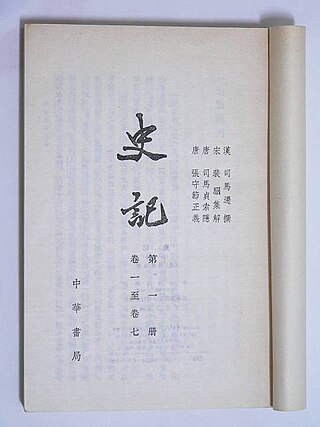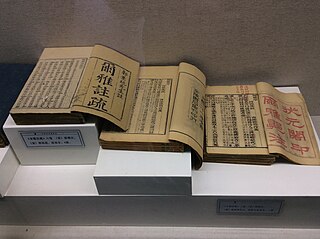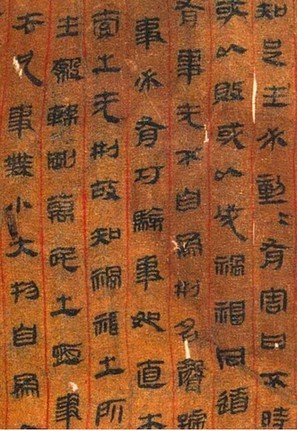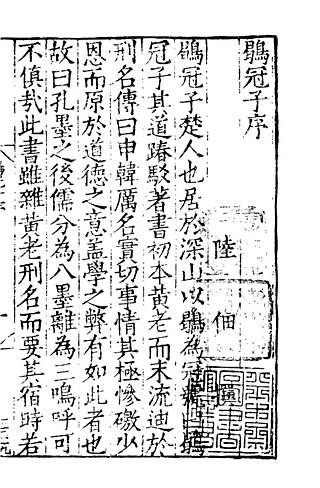
Records of the Grand Historian,also known by its Chinese name Shiji,is a monumental history of China that is the first of China's 24 dynastic histories. The Records was written in the late 2nd century BC to early 1st century BC by the ancient Chinese historian Sima Qian,whose father Sima Tan had begun it several decades earlier. The work covers a 2,500-year period from the age of the legendary Yellow Emperor to the reign of Emperor Wu of Han in the author's own time,and describes the world as it was known to the Chinese of the Western Han dynasty.

The Shuowen Jiezi is a Chinese dictionary compiled by Xu Shen during the Eastern Han dynasty. Although not the first comprehensive Chinese character dictionary,it was the first to analyze the structure of the characters and to give the rationale behind them,as well as the first to use the principle of organization by sections with shared components called radicals.

The Erya or Erh-ya is the first surviving Chinese dictionary. The sinologist Bernhard Karlgren concluded that "the major part of its glosses must reasonably date from the 3rd century BC."

Mathematics emerged independently in China by the 11th century BCE. The Chinese independently developed a real number system that includes significantly large and negative numbers,more than one numeral system,algebra,geometry,number theory and trigonometry.

The Book of the Later Han,also known as the History of the Later Han and by its Chinese name Hou Hanshu,is one of the Twenty-Four Histories and covers the history of the Han dynasty from 6 to 189 CE,a period known as the Later or Eastern Han. The book was compiled by Fan Ye and others in the 5th century during the Liu Song dynasty,using a number of earlier histories and documents as sources.

Huangdi Neijing,literally the Inner Canon of the Yellow Emperor or Esoteric Scripture of the Yellow Emperor,is an ancient Chinese medical text or group of texts that has been treated as a fundamental doctrinal source for Chinese medicine for more than two millennia. The work comprises two texts—each of eighty-one chapters or treatises in a question-and-answer format between the mythical Yellow Emperor and six of his equally legendary ministers.

The Huangdi Sijing are long-lost Chinese texts,manuscripts of which were discovered among the Mawangdui Silk Texts in 1973. Also known as the Huang-Lao boshu,they are thought by modern scholars to reflect a lost branch of early syncretist Daoism,referred to as the "Huang–Lao school of thought" named after the legendary Huangdi and Laozi. One finds in it "technical jargon" derived of Taoism,Legalism,Confucianism and Mohism.
Shuanggudui is an archeological site located near Fuyang in China's Anhui province. Shuanggudui grave no. 1,which belongs to Xiahou Zao (夏侯灶),the second marquis of Ruyin (汝陰侯),was sealed in 165 BCE in the early Han dynasty. Excavated in 1977,it was found to contain a large number of texts written on bamboo strips,including fragments of the Classic of Poetry and the Songs of the South,a text on breathing exercises,a "year table" (年表) recounting historical events,a manual on dogs,a version of the I Ching (Yijing) that differs from the received one,and artifacts including the oldest known cosmic board,a divinatory instrument. Like Mawangdui and Guodian,two other tombs from the area of the old state of Chu,the Shuanggudui find has shed great light on the culture and practices of the early Han dynasty.
The Yi Zhou Shu is a compendium of Chinese historical documents about the Western Zhou period. Its textual history began with a text/compendium known as the Zhou Shu,which was possibly not differentiated from the corpus of the same name in the extant Book of Documents. Western Han dynasty editors listed 70 chapters of the Yi Zhou Shu,of which 59 are extant as texts,and the rest only as chapter titles. Such condition is described for the first time by Wang Shihan in 1669. Circulation ways of the individual chapters before that point are subject to scholarly debates.
The Shizi is an eclectic Chinese classic written by Shi Jiao 尸佼,and the earliest text from Chinese philosophical school of Zajia,which combined ideas from the Hundred Schools of Thought,including Confucianism,Daoism,Mohism,and Legalism. The Shizi text was written c. 330 BCE in twenty sections,and was well known from the Han dynasty until the Song dynasty (960–1279) when all copies were lost. Scholars during the Ming (1368–1644) and Qing (1644–1911) dynasties reconstructed the Shizi from quotations in numerous sources,yet only about 15 percent of the original text was recovered and now extant. Western sinology has largely ignored the Shizi and it was one of the last Chinese classics to be translated into English.
The Shenglei 聲類,compiled by the Cao Wei dynasty lexicographer Li Deng 李登,was the first Chinese rime dictionary. Earlier dictionaries were organized either by semantic fields or by character radicals. The last copies of the Shenglei were lost around the 13th century,and it is known only from earlier descriptions and quotations,which say it was in 10 volumes and contained 11,520 Chinese character entries,categorized by linguistic tone in terms of the wǔshēng 五聲"Five Tones " from Chinese musicology and wǔxíng 五行"Five Phases/Elements" theory.
The Zilin or Forest of Characters was a Chinese dictionary compiled by the Jin dynasty (266–420) lexicographer LüChen (呂忱). It contained 12,824 character head entries,organized by the 540-radical system of the Shuowen Jiezi. In the history of Chinese lexicography,the Zilin followed the Shuowen Jiezi and preceded the Yupian.

The (1066) Leipian 類篇is a Chinese dictionary compiled by Song dynasty (960-1279) lexicographers under the supervision of chancellor Sima Guang. It contains 31,319 character head entries,more than twice as many as the 12,158 in the Yupian,and included many new characters created during the Tang (618-907) and Song dynasties. Leipian entries are arranged by a 544-radical system adapted from the 540 radicals of the classic (121) Shuowen Jiezi.

The (1254) Zitong 字通or Mastery of Characters is a Chinese dictionary of orthography that was compiled by the Southern Song dynasty (1127-1279) scholar Li Congzhou 李從周. It discussed logographic differences among Chinese characters written in the ancient Qin dynasty seal script,standard Han dynasty clerical script,and contemporary Song regular script.
The Cangjiepian,also known as the Three Chapters,was a c. 220 BCE Chinese primer and a prototype for Chinese dictionaries. Li Si,Chancellor of the Qin dynasty,compiled it for the purpose of reforming written Chinese into the new orthographic standard Small Seal Script. Beginning in the Han dynasty,many scholars and lexicographers expanded and annotated the Cangjiepian. By the end of the Tang dynasty (618–907),it had become a lost work,but in 1977,archeologists discovered a cache of texts written on bamboo strips,including fragments of the Cangjiepian.
The Huanglan or Imperial Mirror was one of the oldest Chinese encyclopedias or leishu "classified dictionary". Cao Pi,the first emperor of the Wei,ordered its compilation upon his accession to the throne in 220 and it was completed in 222. The purpose of the Huanglan was to provide the emperor and ministers of state with conveniently arranged summaries of all that was known at the time. Complete versions of the Huanglan existed until the Song dynasty (960-1279),when it became a mostly lost work,although some fragments did survive in other encyclopedias and anthologies. The Huanglan was the prototype of the classified encyclopedia and served as a model for later ones such as the (624) Tang Yiwen Leiju and the (1408) Ming Yongle dadian.

The Shiben or Book of Origins was an early Chinese encyclopedia which recorded imperial genealogies from the mythical Three Sovereigns and Five Emperors down to the late Spring and Autumn period,explanations of the origin of clan names,and records of legendary and historical Chinese inventors. It was written during the 2nd century BC at the time of the Han dynasty. The work was lost in the 10th century,but partially reconstructed from quotations during the Qing dynasty.

The Yiqiejing yinyi is the oldest surviving Chinese dictionary of Buddhist technical terminology,and was the archetype for later Chinese bilingual dictionaries. This specialized glossary was compiled by the Tang dynasty lexicographer monk Xuanying (玄應),who was a translator for the famous pilgrim and Sanskritist monk Xuanzang. When Xuanying died he had only finished 25 chapters of the dictionary,but another Tang monk Huilin (慧琳) compiled an enlarged 100-chapter version with the same title,the (807) Yiqiejing yinyi.

The Yiqiejing yinyi 一切經音義"Pronunciation and Meaning in the Complete Buddhist Canon" was compiled by the Tang dynasty lexicographer monk Huilin 慧琳as an expanded revision of the original Yiqiejing yinyi compiled by Xuanying 玄應. Collectively,Xuanying's 25-chapter and Huilin's 100-chapter versions constitute the oldest surviving Chinese dictionary of Buddhist technical terminology. A recent history of Chinese lexicography call Huilin's Yiqiejing yinyi "a composite collection of all the glossaries of scripture words and expressions compiled in and before the Tang Dynasty" and "the archetype of the Chinese bilingual dictionary".

The Heguanzi is a circa 3rd century BCE syncretic collection of writings from the Chinese Hundred Schools of Thought,particularly the schools of Huang-Lao,Daoism,Legalism,and the Military. The 111 CE Book of Han history is the earliest extant source to mention the Heguanzi,yet the next reliable sources referring to it date from the early 6th century. In 805,the influential Tang dynasty writer Liu Zongyuan found a copy of the Heguanzi and disparaged it as a post-Han apocryphal forgery. His opinion was widely accepted by scholars for the next twelve centuries,during which the text was seldom read and infrequently mentioned. Then,in 1973,Chinese archeologists unearthed the 2nd-century BCE Han dynasty Mawangdui Silk Texts,including the previously unknown Huang-Lao Silk Manuscripts,which have many passages similar and identical with the Heguanzi,leading to renewed studies into its textual history and philosophical significance.













